Essay on Hofstede's Cultural Dimensions and Business Impact
VerifiedAdded on 2023/01/16
|6
|1383
|95
Essay
AI Summary
This essay provides an overview of Hofstede's cultural dimensions, a framework for understanding cross-cultural differences and their impact on business. The essay delves into the dimensions of individualism and collectivism, power distance, and uncertainty avoidance, offering examples and analysis. It presents a personal perspective on the dimensions, disagreeing with certain points and providing suggestions for improvement. The essay highlights the limitations of Hofstede's model in explaining organizational culture and suggests the use of Handy's model for a more comprehensive understanding. The conclusion summarizes the importance of Hofstede's dimensions in cross-cultural communication and emphasizes the need for organizations to consider various cultural models for a deeper understanding of organizational dynamics.
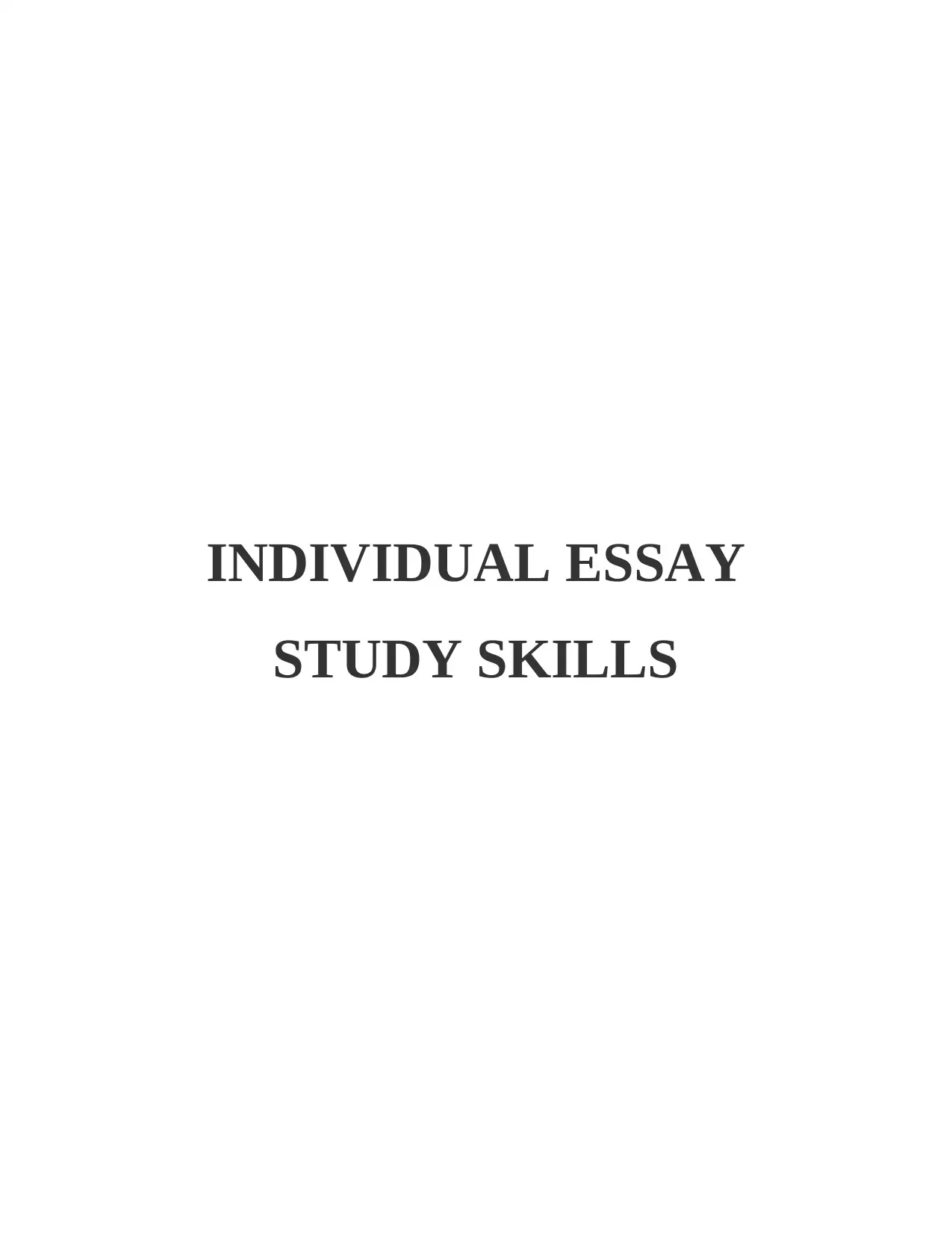
INDIVIDUAL ESSAY
STUDY SKILLS
STUDY SKILLS
Paraphrase This Document
Need a fresh take? Get an instant paraphrase of this document with our AI Paraphraser
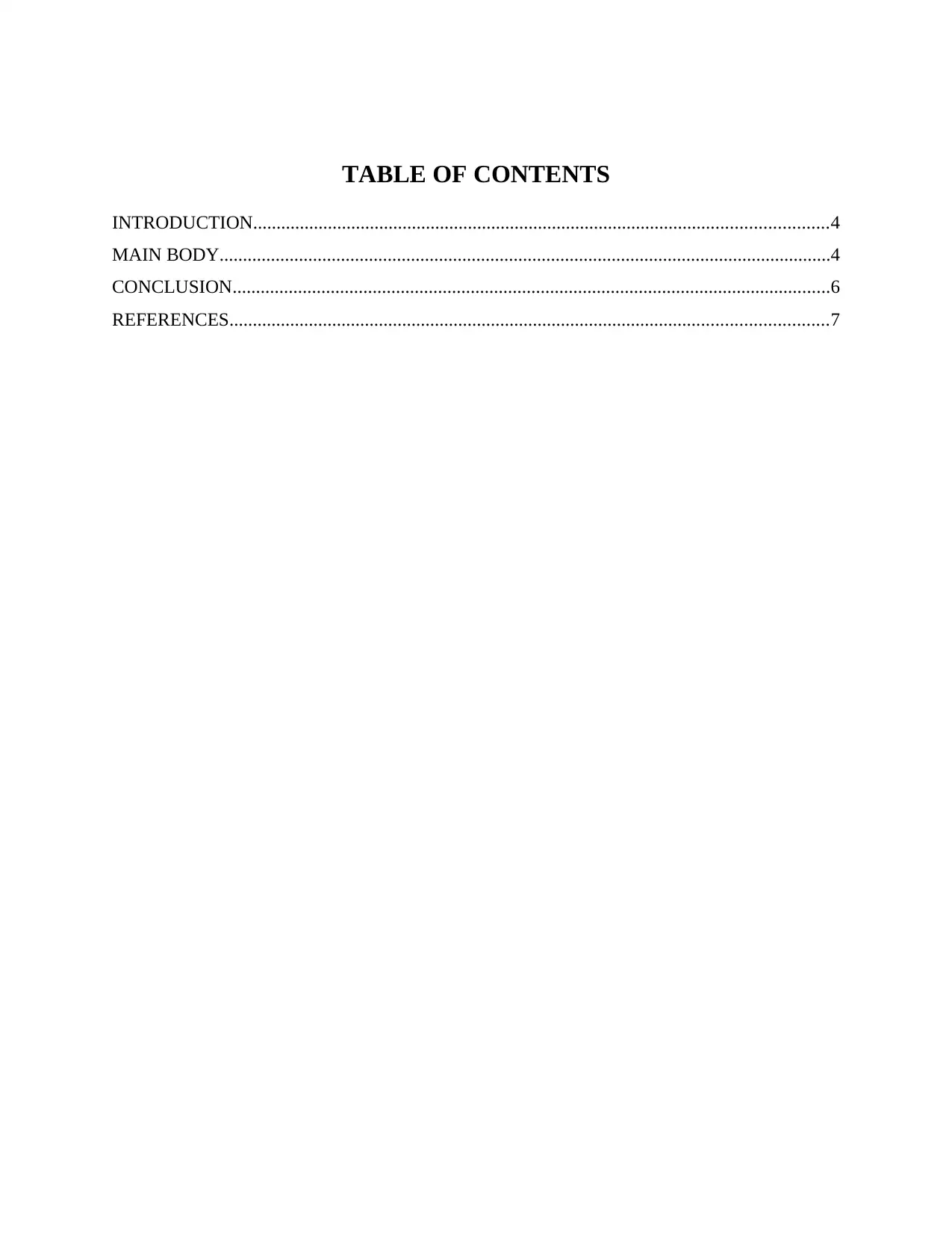
TABLE OF CONTENTS
INTRODUCTION...........................................................................................................................4
MAIN BODY...................................................................................................................................4
CONCLUSION................................................................................................................................6
REFERENCES................................................................................................................................7
INTRODUCTION...........................................................................................................................4
MAIN BODY...................................................................................................................................4
CONCLUSION................................................................................................................................6
REFERENCES................................................................................................................................7
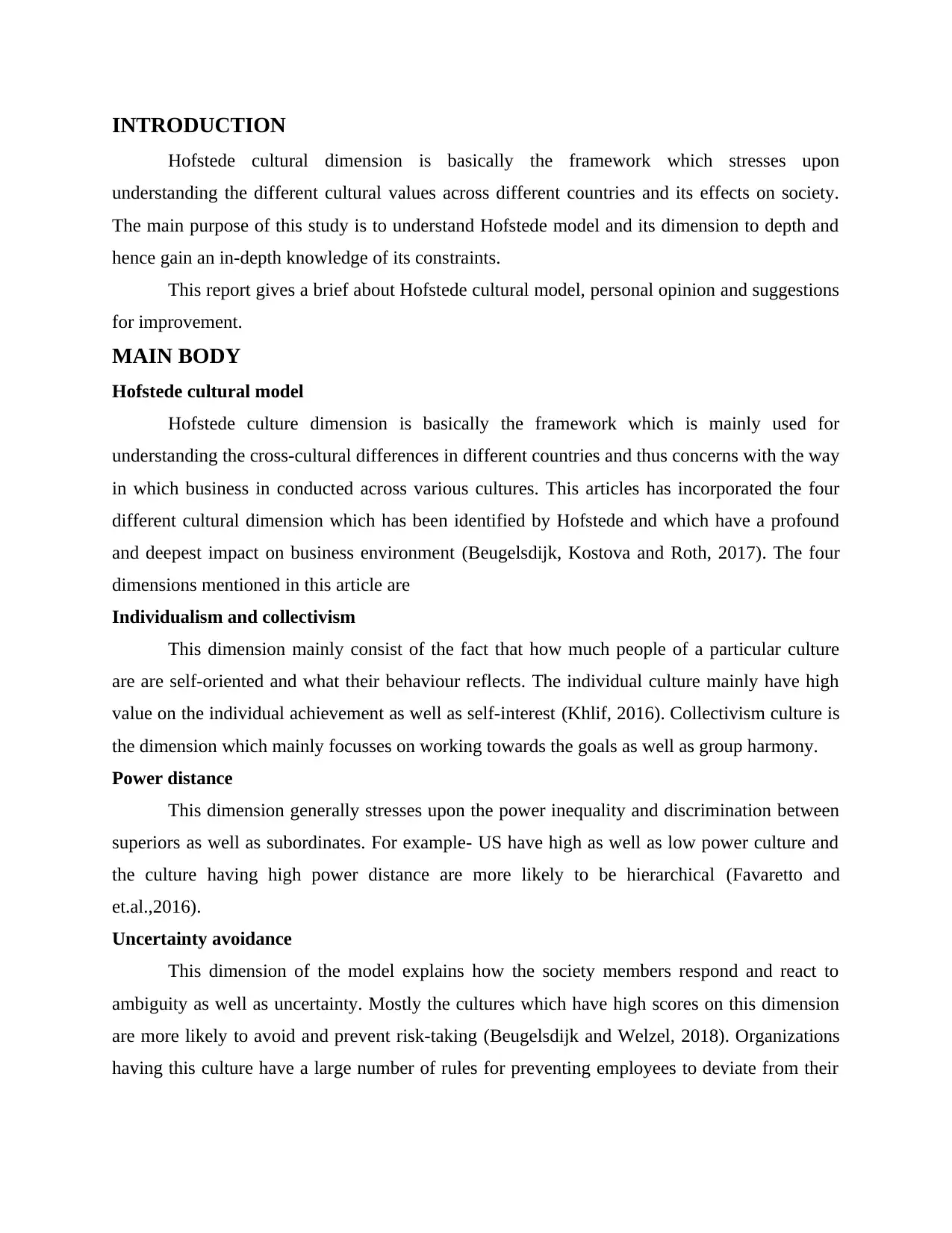
INTRODUCTION
Hofstede cultural dimension is basically the framework which stresses upon
understanding the different cultural values across different countries and its effects on society.
The main purpose of this study is to understand Hofstede model and its dimension to depth and
hence gain an in-depth knowledge of its constraints.
This report gives a brief about Hofstede cultural model, personal opinion and suggestions
for improvement.
MAIN BODY
Hofstede cultural model
Hofstede culture dimension is basically the framework which is mainly used for
understanding the cross-cultural differences in different countries and thus concerns with the way
in which business in conducted across various cultures. This articles has incorporated the four
different cultural dimension which has been identified by Hofstede and which have a profound
and deepest impact on business environment (Beugelsdijk, Kostova and Roth, 2017). The four
dimensions mentioned in this article are
Individualism and collectivism
This dimension mainly consist of the fact that how much people of a particular culture
are are self-oriented and what their behaviour reflects. The individual culture mainly have high
value on the individual achievement as well as self-interest (Khlif, 2016). Collectivism culture is
the dimension which mainly focusses on working towards the goals as well as group harmony.
Power distance
This dimension generally stresses upon the power inequality and discrimination between
superiors as well as subordinates. For example- US have high as well as low power culture and
the culture having high power distance are more likely to be hierarchical (Favaretto and
et.al.,2016).
Uncertainty avoidance
This dimension of the model explains how the society members respond and react to
ambiguity as well as uncertainty. Mostly the cultures which have high scores on this dimension
are more likely to avoid and prevent risk-taking (Beugelsdijk and Welzel, 2018). Organizations
having this culture have a large number of rules for preventing employees to deviate from their
Hofstede cultural dimension is basically the framework which stresses upon
understanding the different cultural values across different countries and its effects on society.
The main purpose of this study is to understand Hofstede model and its dimension to depth and
hence gain an in-depth knowledge of its constraints.
This report gives a brief about Hofstede cultural model, personal opinion and suggestions
for improvement.
MAIN BODY
Hofstede cultural model
Hofstede culture dimension is basically the framework which is mainly used for
understanding the cross-cultural differences in different countries and thus concerns with the way
in which business in conducted across various cultures. This articles has incorporated the four
different cultural dimension which has been identified by Hofstede and which have a profound
and deepest impact on business environment (Beugelsdijk, Kostova and Roth, 2017). The four
dimensions mentioned in this article are
Individualism and collectivism
This dimension mainly consist of the fact that how much people of a particular culture
are are self-oriented and what their behaviour reflects. The individual culture mainly have high
value on the individual achievement as well as self-interest (Khlif, 2016). Collectivism culture is
the dimension which mainly focusses on working towards the goals as well as group harmony.
Power distance
This dimension generally stresses upon the power inequality and discrimination between
superiors as well as subordinates. For example- US have high as well as low power culture and
the culture having high power distance are more likely to be hierarchical (Favaretto and
et.al.,2016).
Uncertainty avoidance
This dimension of the model explains how the society members respond and react to
ambiguity as well as uncertainty. Mostly the cultures which have high scores on this dimension
are more likely to avoid and prevent risk-taking (Beugelsdijk and Welzel, 2018). Organizations
having this culture have a large number of rules for preventing employees to deviate from their
⊘ This is a preview!⊘
Do you want full access?
Subscribe today to unlock all pages.

Trusted by 1+ million students worldwide
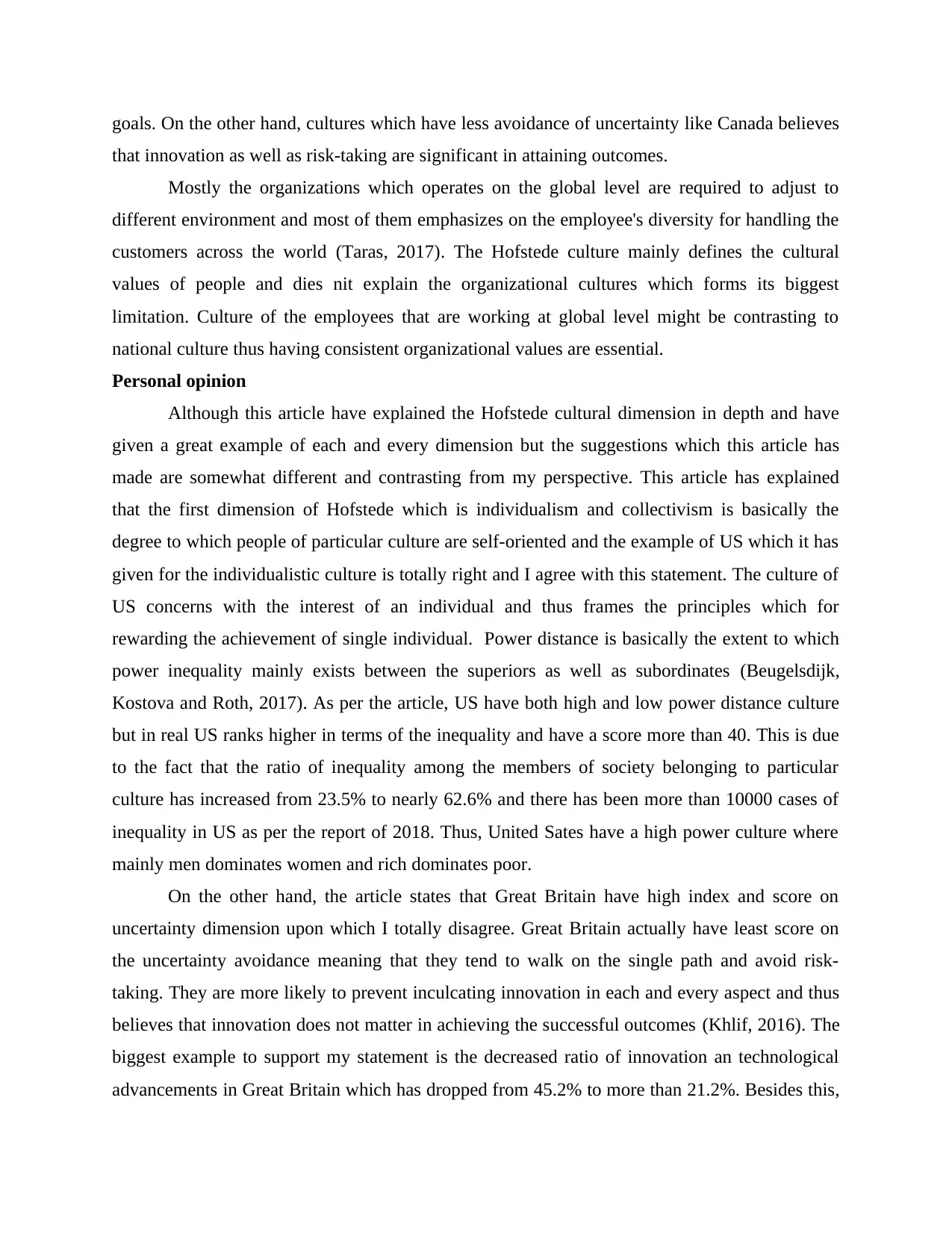
goals. On the other hand, cultures which have less avoidance of uncertainty like Canada believes
that innovation as well as risk-taking are significant in attaining outcomes.
Mostly the organizations which operates on the global level are required to adjust to
different environment and most of them emphasizes on the employee's diversity for handling the
customers across the world (Taras, 2017). The Hofstede culture mainly defines the cultural
values of people and dies nit explain the organizational cultures which forms its biggest
limitation. Culture of the employees that are working at global level might be contrasting to
national culture thus having consistent organizational values are essential.
Personal opinion
Although this article have explained the Hofstede cultural dimension in depth and have
given a great example of each and every dimension but the suggestions which this article has
made are somewhat different and contrasting from my perspective. This article has explained
that the first dimension of Hofstede which is individualism and collectivism is basically the
degree to which people of particular culture are self-oriented and the example of US which it has
given for the individualistic culture is totally right and I agree with this statement. The culture of
US concerns with the interest of an individual and thus frames the principles which for
rewarding the achievement of single individual. Power distance is basically the extent to which
power inequality mainly exists between the superiors as well as subordinates (Beugelsdijk,
Kostova and Roth, 2017). As per the article, US have both high and low power distance culture
but in real US ranks higher in terms of the inequality and have a score more than 40. This is due
to the fact that the ratio of inequality among the members of society belonging to particular
culture has increased from 23.5% to nearly 62.6% and there has been more than 10000 cases of
inequality in US as per the report of 2018. Thus, United Sates have a high power culture where
mainly men dominates women and rich dominates poor.
On the other hand, the article states that Great Britain have high index and score on
uncertainty dimension upon which I totally disagree. Great Britain actually have least score on
the uncertainty avoidance meaning that they tend to walk on the single path and avoid risk-
taking. They are more likely to prevent inculcating innovation in each and every aspect and thus
believes that innovation does not matter in achieving the successful outcomes (Khlif, 2016). The
biggest example to support my statement is the decreased ratio of innovation an technological
advancements in Great Britain which has dropped from 45.2% to more than 21.2%. Besides this,
that innovation as well as risk-taking are significant in attaining outcomes.
Mostly the organizations which operates on the global level are required to adjust to
different environment and most of them emphasizes on the employee's diversity for handling the
customers across the world (Taras, 2017). The Hofstede culture mainly defines the cultural
values of people and dies nit explain the organizational cultures which forms its biggest
limitation. Culture of the employees that are working at global level might be contrasting to
national culture thus having consistent organizational values are essential.
Personal opinion
Although this article have explained the Hofstede cultural dimension in depth and have
given a great example of each and every dimension but the suggestions which this article has
made are somewhat different and contrasting from my perspective. This article has explained
that the first dimension of Hofstede which is individualism and collectivism is basically the
degree to which people of particular culture are self-oriented and the example of US which it has
given for the individualistic culture is totally right and I agree with this statement. The culture of
US concerns with the interest of an individual and thus frames the principles which for
rewarding the achievement of single individual. Power distance is basically the extent to which
power inequality mainly exists between the superiors as well as subordinates (Beugelsdijk,
Kostova and Roth, 2017). As per the article, US have both high and low power distance culture
but in real US ranks higher in terms of the inequality and have a score more than 40. This is due
to the fact that the ratio of inequality among the members of society belonging to particular
culture has increased from 23.5% to nearly 62.6% and there has been more than 10000 cases of
inequality in US as per the report of 2018. Thus, United Sates have a high power culture where
mainly men dominates women and rich dominates poor.
On the other hand, the article states that Great Britain have high index and score on
uncertainty dimension upon which I totally disagree. Great Britain actually have least score on
the uncertainty avoidance meaning that they tend to walk on the single path and avoid risk-
taking. They are more likely to prevent inculcating innovation in each and every aspect and thus
believes that innovation does not matter in achieving the successful outcomes (Khlif, 2016). The
biggest example to support my statement is the decreased ratio of innovation an technological
advancements in Great Britain which has dropped from 45.2% to more than 21.2%. Besides this,
Paraphrase This Document
Need a fresh take? Get an instant paraphrase of this document with our AI Paraphraser
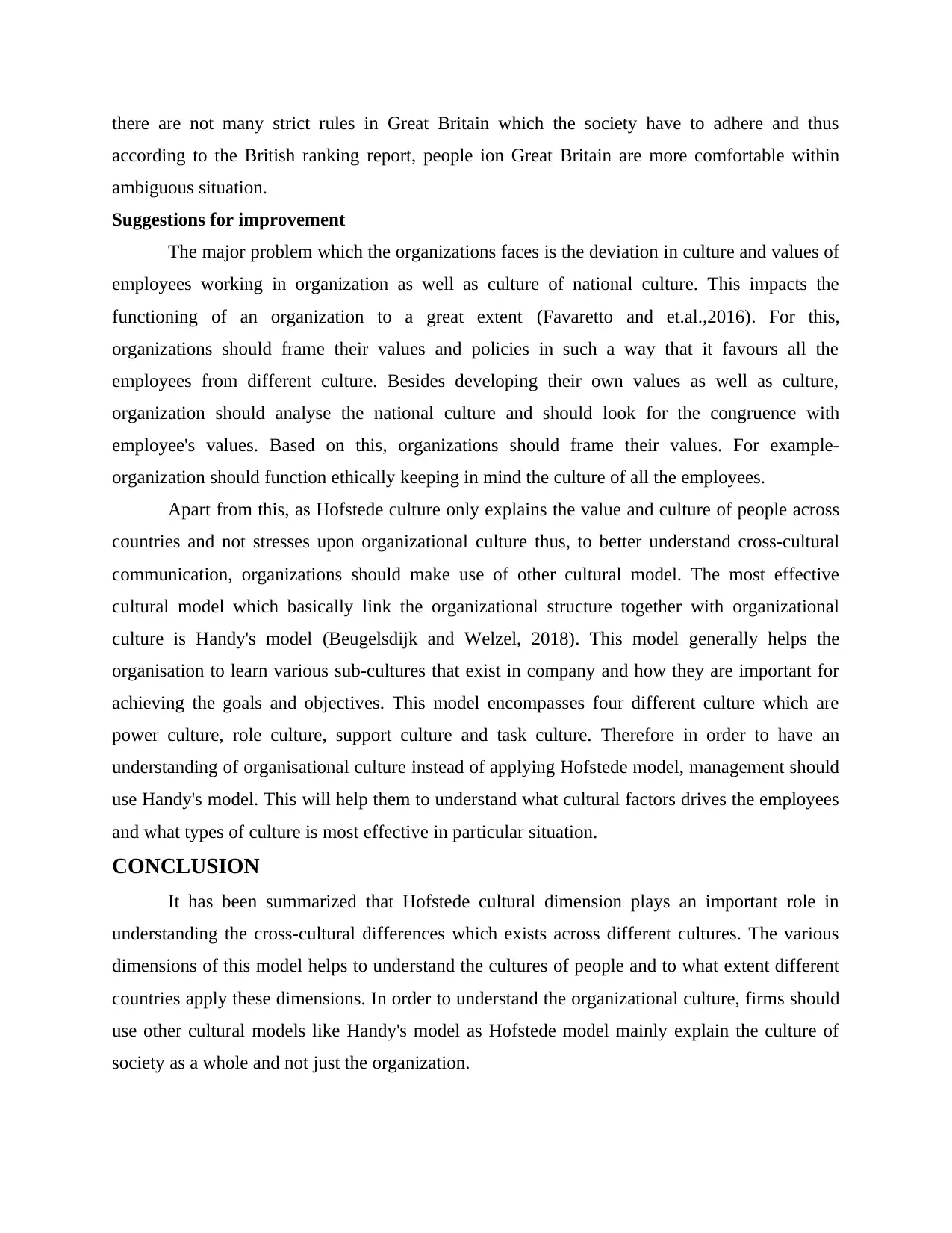
there are not many strict rules in Great Britain which the society have to adhere and thus
according to the British ranking report, people ion Great Britain are more comfortable within
ambiguous situation.
Suggestions for improvement
The major problem which the organizations faces is the deviation in culture and values of
employees working in organization as well as culture of national culture. This impacts the
functioning of an organization to a great extent (Favaretto and et.al.,2016). For this,
organizations should frame their values and policies in such a way that it favours all the
employees from different culture. Besides developing their own values as well as culture,
organization should analyse the national culture and should look for the congruence with
employee's values. Based on this, organizations should frame their values. For example-
organization should function ethically keeping in mind the culture of all the employees.
Apart from this, as Hofstede culture only explains the value and culture of people across
countries and not stresses upon organizational culture thus, to better understand cross-cultural
communication, organizations should make use of other cultural model. The most effective
cultural model which basically link the organizational structure together with organizational
culture is Handy's model (Beugelsdijk and Welzel, 2018). This model generally helps the
organisation to learn various sub-cultures that exist in company and how they are important for
achieving the goals and objectives. This model encompasses four different culture which are
power culture, role culture, support culture and task culture. Therefore in order to have an
understanding of organisational culture instead of applying Hofstede model, management should
use Handy's model. This will help them to understand what cultural factors drives the employees
and what types of culture is most effective in particular situation.
CONCLUSION
It has been summarized that Hofstede cultural dimension plays an important role in
understanding the cross-cultural differences which exists across different cultures. The various
dimensions of this model helps to understand the cultures of people and to what extent different
countries apply these dimensions. In order to understand the organizational culture, firms should
use other cultural models like Handy's model as Hofstede model mainly explain the culture of
society as a whole and not just the organization.
according to the British ranking report, people ion Great Britain are more comfortable within
ambiguous situation.
Suggestions for improvement
The major problem which the organizations faces is the deviation in culture and values of
employees working in organization as well as culture of national culture. This impacts the
functioning of an organization to a great extent (Favaretto and et.al.,2016). For this,
organizations should frame their values and policies in such a way that it favours all the
employees from different culture. Besides developing their own values as well as culture,
organization should analyse the national culture and should look for the congruence with
employee's values. Based on this, organizations should frame their values. For example-
organization should function ethically keeping in mind the culture of all the employees.
Apart from this, as Hofstede culture only explains the value and culture of people across
countries and not stresses upon organizational culture thus, to better understand cross-cultural
communication, organizations should make use of other cultural model. The most effective
cultural model which basically link the organizational structure together with organizational
culture is Handy's model (Beugelsdijk and Welzel, 2018). This model generally helps the
organisation to learn various sub-cultures that exist in company and how they are important for
achieving the goals and objectives. This model encompasses four different culture which are
power culture, role culture, support culture and task culture. Therefore in order to have an
understanding of organisational culture instead of applying Hofstede model, management should
use Handy's model. This will help them to understand what cultural factors drives the employees
and what types of culture is most effective in particular situation.
CONCLUSION
It has been summarized that Hofstede cultural dimension plays an important role in
understanding the cross-cultural differences which exists across different cultures. The various
dimensions of this model helps to understand the cultures of people and to what extent different
countries apply these dimensions. In order to understand the organizational culture, firms should
use other cultural models like Handy's model as Hofstede model mainly explain the culture of
society as a whole and not just the organization.
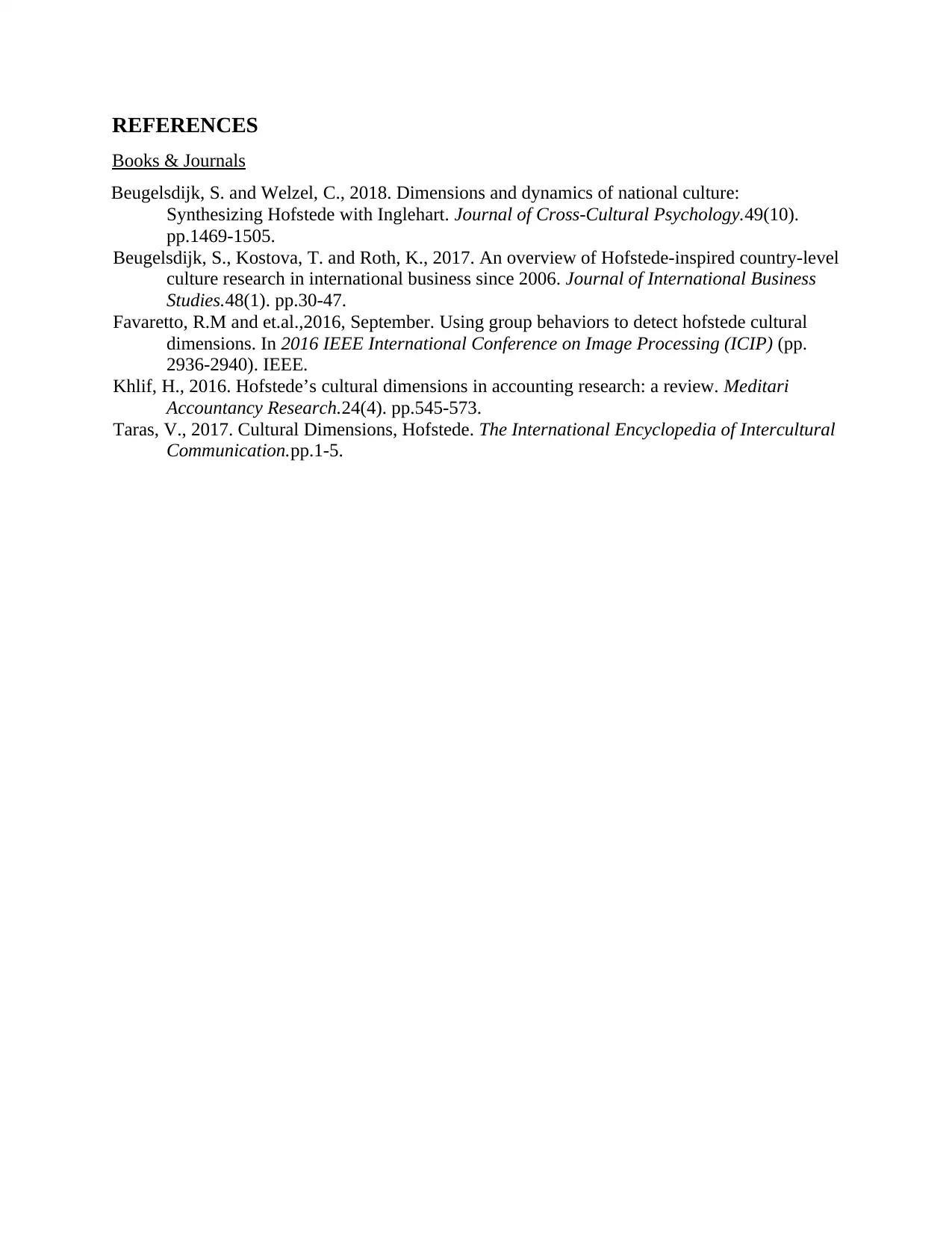
REFERENCES
Books & Journals
Beugelsdijk, S. and Welzel, C., 2018. Dimensions and dynamics of national culture:
Synthesizing Hofstede with Inglehart. Journal of Cross-Cultural Psychology.49(10).
pp.1469-1505.
Beugelsdijk, S., Kostova, T. and Roth, K., 2017. An overview of Hofstede-inspired country-level
culture research in international business since 2006. Journal of International Business
Studies.48(1). pp.30-47.
Favaretto, R.M and et.al.,2016, September. Using group behaviors to detect hofstede cultural
dimensions. In 2016 IEEE International Conference on Image Processing (ICIP) (pp.
2936-2940). IEEE.
Khlif, H., 2016. Hofstede’s cultural dimensions in accounting research: a review. Meditari
Accountancy Research.24(4). pp.545-573.
Taras, V., 2017. Cultural Dimensions, Hofstede. The International Encyclopedia of Intercultural
Communication.pp.1-5.
Books & Journals
Beugelsdijk, S. and Welzel, C., 2018. Dimensions and dynamics of national culture:
Synthesizing Hofstede with Inglehart. Journal of Cross-Cultural Psychology.49(10).
pp.1469-1505.
Beugelsdijk, S., Kostova, T. and Roth, K., 2017. An overview of Hofstede-inspired country-level
culture research in international business since 2006. Journal of International Business
Studies.48(1). pp.30-47.
Favaretto, R.M and et.al.,2016, September. Using group behaviors to detect hofstede cultural
dimensions. In 2016 IEEE International Conference on Image Processing (ICIP) (pp.
2936-2940). IEEE.
Khlif, H., 2016. Hofstede’s cultural dimensions in accounting research: a review. Meditari
Accountancy Research.24(4). pp.545-573.
Taras, V., 2017. Cultural Dimensions, Hofstede. The International Encyclopedia of Intercultural
Communication.pp.1-5.
⊘ This is a preview!⊘
Do you want full access?
Subscribe today to unlock all pages.

Trusted by 1+ million students worldwide
1 out of 6
Related Documents
Your All-in-One AI-Powered Toolkit for Academic Success.
+13062052269
info@desklib.com
Available 24*7 on WhatsApp / Email
![[object Object]](/_next/static/media/star-bottom.7253800d.svg)
Unlock your academic potential
Copyright © 2020–2025 A2Z Services. All Rights Reserved. Developed and managed by ZUCOL.




